‘The state of the nervous system is what dictates health or disease in any one body’ ~ Irene Lyon
With Springs arrival in Western Australia and the change of seasons, illness, coughs, colds and allergies escalate.
It’s got me curious….
If the nervous system dictates health or dis-ease in the body, WHY do people get sick with the change of seasons?
I’ve always thought it’s because there are a few more bugs around. But is there more to it?
Yes.
It seems the state of our brain (no matter the season) has a critical part to play.
Here’s why;
A Belgian study by Dr. Gilles Vandewalle, a neuroscientist, showed our brains respond to the changing seasons.
He cites, “Mood and immunity are well known to change with seasons in humans and there are indications that several brain aspects could also be seasonal.”
So perhaps the ‘seasonal change’ in our brains is what affects our mood and immunity with the change of seasons or vice versa?

Spring Boronia
And why SAD, Seasonal Affective Disorder, is experienced through the winter months. SAD is a condition associated with feelings of hopelessness, low energy, changes in sleep or eating patterns.
Or why there is evidence that shows a higher incidence of suicide in late spring / early summer. In fact Australias’ national day of action, R U OK day to support people struggling with lifes’ ups and downs, was this week, September 12th. There are many, many significant factors associated with suicide, yet the seasons / weather also seems to be influential.
It’s a timely reminder to take even more time to be with those you are close to and who are a little more vulnerable at this transitional time of year and check in with how they are going? Really?
How the brain governs our body.
There’s an intimate connection between our brain and our body and this connection affects far more than our mood and immunity. It can affect inflammation, the endocrine (hormonal) system, circulation (the heart) and even metabolism!
Via this connection the brain fundamentally governs our body.
The connection being….
The vagus!
If you haven’t heard of it, keep reading, it might just reset your entire well-being & it’s FUN.
Viva Las Vagus!
The vagus is the longest nerve in the body, connecting the brain with the Gut, heart, liver, pancreas, gallbladder, kidney, lungs, mouth and more…
Vagus means wanderer in Latin, which is how the Vagus works, wandering around the body through the organs.
The vagus sends information about the state of our organs back and forth to the brain. Therefore if the vagus system isn’t functioning well or ‘toned’ – this important communication network malfunctions, potentially affecting every organ and system within us.
For example, this connection helps regulate;
Tone your vagus. Regulate your stress.
Let’s get sciency for a moment.
The vagus is the main component of your parasympathetic nervous system i.e. your rest and digest response – which is also where the healing state is most likely to occur.
Without going into too much technical detail, the tone (‘health’) of the vagus nerve regulates your tolerance to stress (fight and flight response)! With 60 – 80% of Doctors visits being stress related and most illness directly relating to stress, the tone of your vagus nerve, has a key role in protecting you from dis-ease.

5 examples of this intimate connection at play;
https://www.psychologytoday.com/au/blog/the-athletes-way/201607/vagus-nerve-stimulation-dramatically-reduces-inflammation
And if you’ve lost connection to your gut instinct (your intuition) or not sure what I’m on about, then perhaps that’s another reason your vagus needs a little more toning too.
If you suffer from an inflammatory condition, digestive upset, blood pressure issues or mood disorders, perhaps it’s time to take a closer look at your vagal tone?
11 simple ways to tone your vagus.
1. Deep, diaphragmatic breathing with a long exhale.
Breathing deep instantly initiates the ‘rest and digest’ response i.e. the parashympathetic nervous system and the vagus – which is thereby in charge of turning off the ‘fight or flight’ reflex.”!
In doing this it can simultaneously work to reduce heart rate and blood pressure – all by taking a few deep breathes!
Other quick and easy ways to tone the vagus;
So many simple and FUN ways to keep your being well!
Which one or two can you start to add in?

Perhaps adopt the latest craze of ice bathing! You don’t have to fly to Alaska, a cold shower or a dip in a cold ocean in winter does the trick…
Summary
Our bodies are complex and none more so than the physiology of our brains, the conductor. Therein – intimately connected to every organ, every system and ultimately every thing. To then treat the body within it’s unique parts, rather than as a whole, is to simply place a bandaid on the symptom, rather than exploring the root cause for ultimate healing – which is likely to lead to the brain & the gut.
The vagus nerve plays a vital role in the process & the gut/brain axis, maintaining homeostasis (balance) in the body including; inflammation, digestion, the regulation of food intake, satiety, stress tolerance and energy.
Hence why seasonal changes, which can initiate changes in the brain / nervous system have a direct impact on our vital bodily functions, such as our immunity, mood, digestion and so much more.
So now you’ve got a few more great reasons to relax your nervous system, tone your vagus and stress less…
Viva Las Vagus!
References;
https://www.ncbi.nlm.nih.gov/pmc/articles/PMC5859128/
https://www.huffingtonpost.com.au/entry/brain-activity-seasons-study_
https://www.ncbi.nlm.nih.gov/pmc/articles/PMC3315262/
https://www.pnas.org/content/early/2016/02/04/1518129113
https://blog.daveasprey.com/vagus-nerve-vagal-response/
‘Cooking with love provides food for the soul’
It’s no coincidence the word art forms the word Heart.
Art: the expression of creativity and imagination… It’s about producing works to be appreciated for their beauty or emotional power.
Heart symbolises Love. It is known as the seat of emotions, the heart is synonymous with affection. And art has the power to ignite these heartfelt emotions.
Heart, love and food.
… The preparation of home made food then is artistic. When we are creating recipes from beautiful raw ingredients, creating delicious, appetising food, nourishing loved ones, we evoke feelings (emotions) of warmth, happiness and love. When we feel deeply, we create life long memories that we can revisit in an instant, evoking those same loving memories. It touches our heart.
So, when I saw an article in the West Australian, ‘Children just 8 and on diet apps’ it saddened me and fired me up…
Firstly. There’s something about Lamb Chops!
My most favourite foodie memory is returning home to our family farm from boarding school. We’d often get home around 6 – 7pm, just in time for dinner and be hopeful or having put in our order, for Mums home made, crumbed lamb chops! For all 3 of us kids it was our favourite family meal. A recipe handed down from my Grandmother to my mum. Lamb chops made everything feel right again. We’d eat it together, sharing our stories of school, what had been happening on the farm, the world and catching up after spending time away from each other.
And I fondly remember after travelling overseas for a year, it was the first home cooked meal that mum made for me. I felt happy. I felt loved. I felt home.
But food does that doesn’t it?!
Food has the power to bring us together. It’s the vehicle for sparking engaging (emotive) conversation, appreciation and love for the time and energy spent preparing and creating it. Reward in giving and receiving equally. It evokes feelings and life long memories. And although Mums crumbed lamb chops may not have been especially ‘beautiful’ they certainly had emotional power i.e. it touched my he(art).
There’s an app for that…
Which brings me to the new weight loss app for children aged eight to seventeen. An app that’s been developed in the USA to help kids manage their weight. ‘Designed to be simple, fun and effective’. The app encourages kids to track their own weight and food intake and monitor their diet based on a traffic light system’
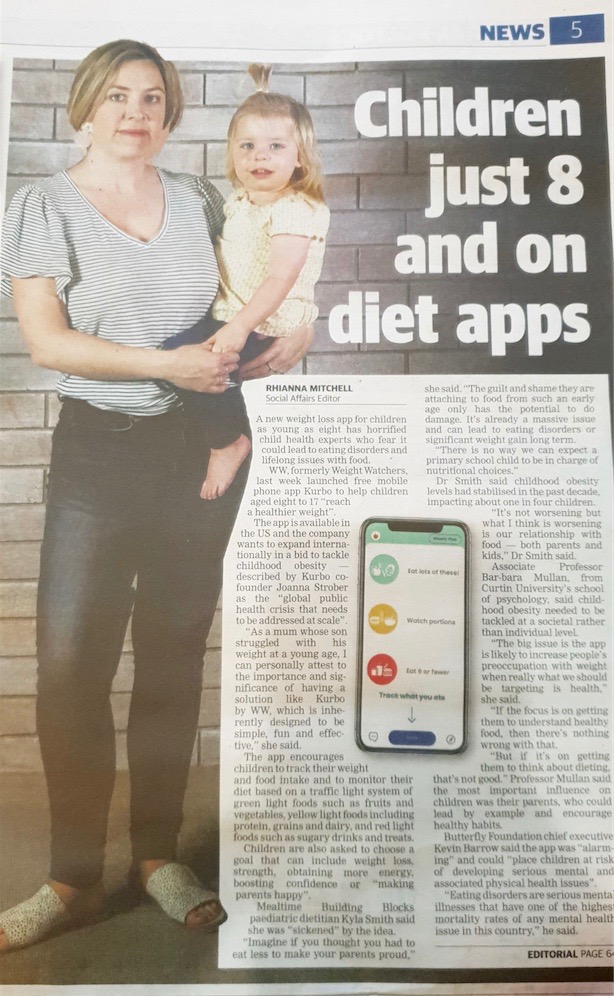
Argh. I cannot believe our most natural relationship with food has come to this? Children learning what food they need to eat from an app. It’s not right and it’s not healthy.
For me, it’s another commercial bandaid, designed with good intention (?) that’s covering up two deeper dysfunctional, societal issues at play.
First up.
When we eat foods in their most whole and real form i.e. unprocessed and unrefined, there is no app needed. Children have a much greater chance of maintaining their weight, easily, naturally, with no overthinking or digital device required.
However there is a trick.
Eating whole foods requires some preparation time, energy, a touch of creativity and hopefully a healthy dose of love. In eating food this way, the benefits are 100x worth it.
The simple act of preparing food at home with our families is one of the most important acts we can perform, (even if you think you can’t cook, give it go, it’s so worth it).
In our homes, while preparing and creating food, we powerfully create;
Looking at an app on a device, getting takeaway or store-bought meals, creates missed opportunities and a void for the most fundamental of these human needs to be met.
The app is a bandaid. There may be a place for it, but not before exploring if it’s in-fact covering up these two deeper issues.
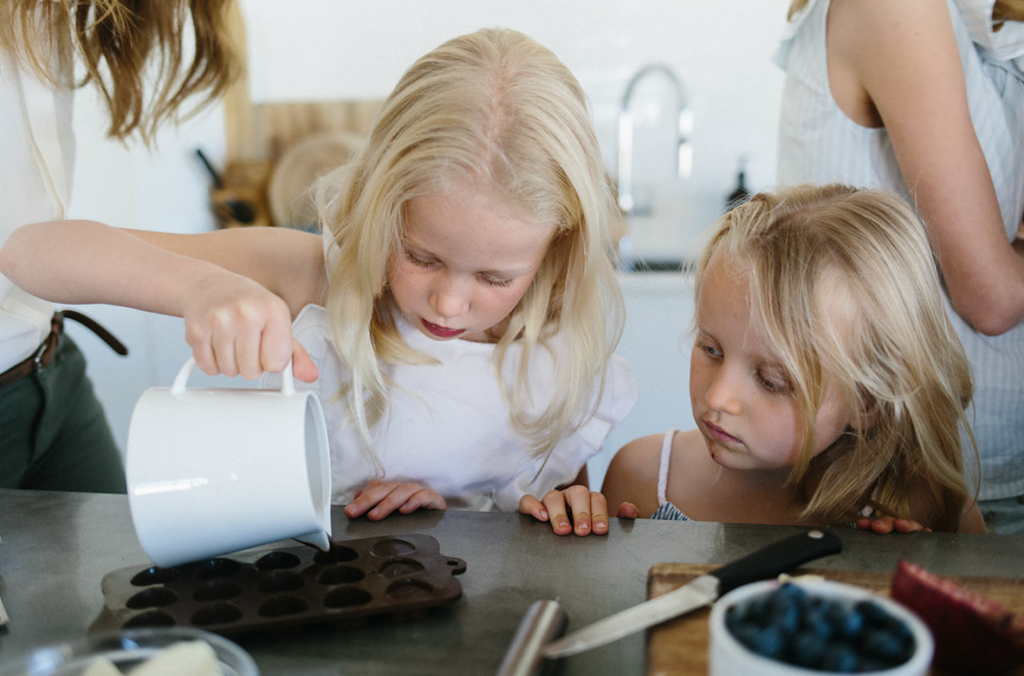
Re-discovering the he(art) of food and our childrens’ health.
1. Outsourcing responsibility.
Parenting is busy and at the same time, it’s become very easy and the norm, to outsource food preparation, meaning we no longer need to prioritise time for the simple and most important art of creating home made food with our families, sharing, explaining, learning about the food and eating, enjoying it together.
Rather we are outsourcing it for the convenience of packaged food, takeaway or… an app.
Life is busy and it’s an easy choice to grab something ready to go and every now and again, that’s totally fine, but when you do, take a moment to eat it together, mindfully and gratefully.
Preparing and creating a meal at home IS the most simple, fundamental and important act there can be as a Parent.
2. Convenience.
The convenience of modern day living is inconveniencing and affecting the health of our families.
Take a moment next time you’re tempted to make a time efficient choice and decide if you really need to outsource that action or say ‘yes’ to that activity or event or if it’s actually better and potentially more enjoyable, to say ‘no’ or ‘I’m going to do it myself, together’?
When we’re too busy to properly cook, it’s easy to be drawn into societal norms without thinking twice, and actually when we take time to think it through the easy way out is usually not in the best interest of your or your families well-being.
Restoring our relationship with food, a culinary adventure.
In our recent visit to France, we experienced a culinary adventure with the beautiful and charismatic Mimi Thorisson and her family. Mimi has created a lifestyle business, one that seamlessly combines her life, business and family. I think living life this way makes life easier and something I aspire to.
Generally, French people are amongst the healthiest in the world, and their children have the lowest incidence of obesity in the world.
I learnt why.

Food isn’t convenient, it’s at the heart of their lives, especially for Mimi. While we were there, we didn’t see any advertising promoting fast food, (actually very little advertising in general).
Here’s what I learnt about Mimi’s philosophy / relationship with food, and I love;
It was an incredible experience, sparked by a common love of good food, shared with strangers who quickly became wonderful friends with life long memories made. (And if you haven’t discovered Mimi yet, you can find her on instagram and enjoy her many cook books).
The simplicity of good food and what it has the power to create, really is magic.
But… I know as Mothers this might sounds like a fantasy! We can quickly lose the energy for preparing and cooking home made food, especially if children are turning up their noses up at it! I know how it is. I definitely have days like this too. So keep reading… I have something that will help.
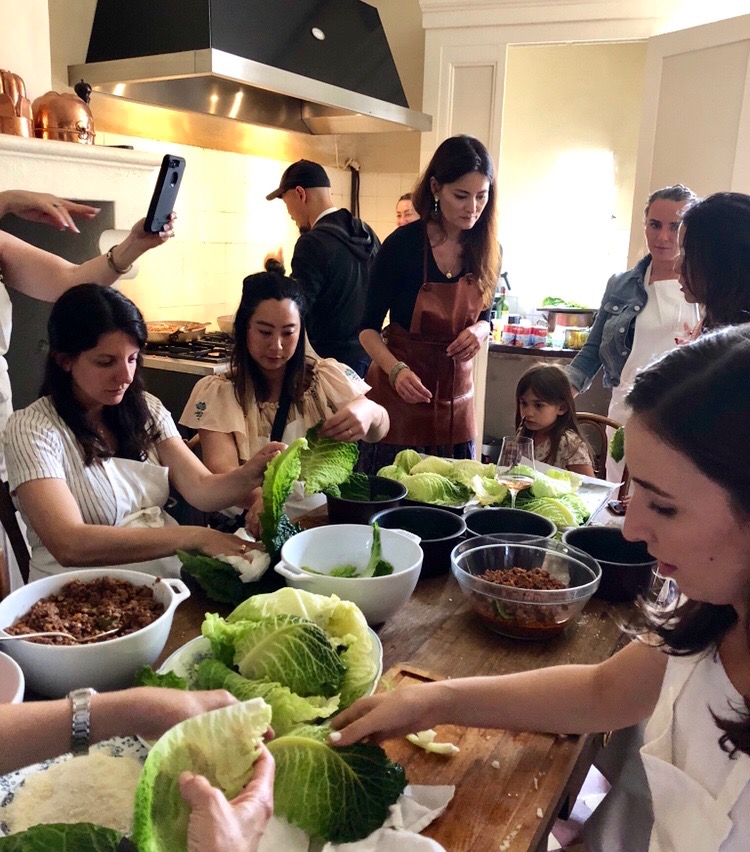
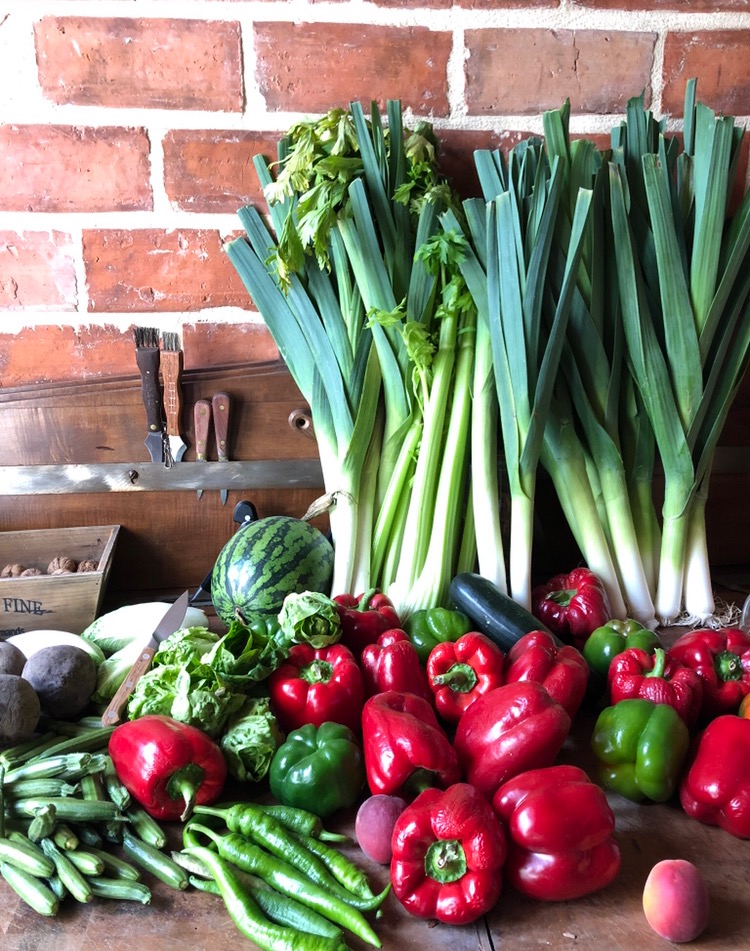
The Summer Abundance Workshop with Mimi.
In Summary
Childhood obesity is one of the most serious global public health challenges of the 21st century, affecting every country in the world. And it needs to be addressed there is no question but unfortunately an app or food monitoring is not the solution. Rather it’s another (in)convenient, quick fix that doesn’t get to the deeper issues at play.
Kids don’t need more reasons to be on their devices, especially as an 8 year old. There is much more to managing childrens’ weight than monitoring the food they’re eating.
Briefly, holding weight, for any of us, also relates to;
If these issues aren’t addressed as well, then no matter what we eat, or what app we use, we won’t release unnecessary weight.
We are emotional (feeling) beings.
Emotional wellbeing is equally if not more important than the food we eat, yet food has a pivotal role in creating the space that brings us together which helps in regulating emotional wellbeing.
Our children (and we) need, connection, engagement and stimulation of their senses. As their parents we are the primary creators of experiences to expose them to these experiences and the preparation of food is a simple, everyday act that is the perfect way to create this.
The power, connection and emotion that comes from preparing a simple meal together from beautiful raw ingredients and then what that creates when it’s taken to the table, everyone gathers and sits down to enjoy it and eat it together. There is magic in the memories made, the pride taken, the love shown in those moments. It can not be understated. Just like a simple meal of crumbed lamb chops.
Let’s reconnect with the joy and the memories that preparing and creating food creates. If we are preparing and creating food at our tables, we don’t need apps or digital devices and kids will never have to worry about ‘watching their weight’ and have the time and ‘head space’ they NEED in todays world, for fulfilling their most basic, intrinsic needs for health and happiness.
The positive relationship with food our children need can only be fostered by us, their parents or their primary caregivers. There is nobody else and ultimately, I don’t think any of us want it any other way.
What is your relationship with food and how is that affecting your childrens relationship with food? I’d love to hear your thoughts.
Let’s GLOW!
If you are lacking the energy, motivation or inspiration to create these magical foodie memories and moments in your home or the whole idea seems like a fantasy… I understand. I’ve been there too, and it can feel hard. I know when I’m feeling good, I’m happier and I’m more interested in cooking for my family and to be honest, engaged with my family. Sometimes we need a healthy kickstart…

If you can relate to this, a healthy kickstart is just what you need for you and your family. It’s time to Get Up & GLOW!
GLOW is my 21 day vitality reset protocol, nourishing for mind, body and soul to get you back to your radiant self, glowing from the inside out.
It is the ultimate healthy kickstart. Do it for you or do it for your family. We start next Friday 30th of August. I hope you can join me. Register here.
And in the meantime enjoy making your foodie memories.
In brief here’s how our posture fundamentally affects our vitality and wellbeing;
1. Our energy increases. With better posture, muscles function better and therefore the nervous system and vice versa operates better, hence improving our overall energy. For example, you may have noticed in some children with poor muscle tone, that they can tire quicker than other children.
2. Stress reduces. With the nervous system functioning better, stress is better tolerated and mood improves. When the body is slumped/crouched, it’s also a position that ancestrally protects the vital organs. This response then also signals to the (ancestral) brain there’s a potential danger and heightens the bodies stress response.
3. Wellbeing improves. If the body is better aligned i.e. posture improved, the body is automatically more open. Therefore digestion, respiration, circulation etc all function better. For example, try this quick exercise. Consciously move to a slumped position and try deep breathing or eating your food?… It’s not easy or comfortable, is it? Posture affects how well we digest and absorb food plus the ability to breathe well i.e. deeply. With a shallow breathe i.e. from the chest this action also initiates the bodies sympathetic nervous system i.e. fight and flight/stress.
Interestingly, another indicator for longevity is glute strength! Those areas in the world known for longevity, the blue zones, also show that elders squat regularly in their day and have strong glute muscles. The gluteus (glutes) are comprised of 3 muscles. They are one of the largest muscle groups in the body. If they’re strong and used often, they’re going to affect our natural energy as well as our posture.
4. Injury prevention (& pain management). When the body is aligned and moving well, then we are far less likely to endure injury or pain. This is a big motivator for me in improving my posture and bodies alignment. I want to be able to keep running. I found This TED talk by Annette Verpillot, founder of Posture pro fascinating.
Poor posture.
Commonly we think poor posture is a result of not being conscious of how we’re carrying our body or laziness.
It’s actually more likely to be a result of poor muscle strength, particularly core or glute strength which can relate back to the feet, the nervous system and therefore how well the body is communicating to the brain & vice versa.
Why we need happy feet.
Our feet are some of the most nerve-rich parts of our body, directly communicating to our brain.
The brain relies on sensory receptors in our feet & other areas to gather info. To achieve this our feet need to touch their environment ie ideally barefoot.
Yet our often neglected feet, spend most of the time packaged up in shoes & not getting the sensory touch they (our brain) needs…
The foot not only helps us move but it’s also used by the brain to make subtle adjustments in our gait to protect bones and joints all the way up the body and to maximize the efficiency of how we move.
It makes sense then that how well we move actually depends on how well our feet (& ankles) move. And of course, for our childrens’ developing brains, barefoot or soft soled shoes are even more important.
What I’ve noticed.
Personally, I’ve found that the weakness in my left leg etc. originates back to childhood, when I broke a big toe and learnt to walk on the left side of my foot rather than the ball of the foot which has affected my whole left side (as different muscles were used for daily movement). The left side of the body is the side of our feminine energy and influences the right/creative side of the brain.
I don’t know for sure, but from all that I’m learning is it’s a likely explanation and has repercussions for emotional wellbeing and much more.
And naturally, if the body isn’t aligned, then ultimately it can predispose us for dis-ease.
So here’s what I’m loving and is helping me strengthen my feet, toes, glutes and overall muscular/nervous system and ultimately brain health (I hope).
The moves I’m making.
I’d like to say meditation but I’m yet to get a regular practice happening! It’s all work in progress, and I haven’t jumped to all of the above at once, no way… it’s been a natural progression and now I use different modalities depending on what my body needs. So if you’re interested don’t feel you need to do it all at once, do what feels right, one nourishing ‘step’ at a time.
Keeping moving.
In the research I’ve been doing and the changes I’ve been making in my own movement / posture practices, I’ve begun to understand that movement is MORE important than the food we’re eating! The affect is so significant on the nervous system that it means we digest and absorb our food so much better.
Now take a moment to consider where there might be a ‘kink’ or two in your (& your childrens) incredibly intelligent body that could benefit from a little more love and attention?
If this information resonates for you then begin with one small change at a time e.g. being barefoot more often or giving your feet a bit more movement rather than being packaged up in shoes all day or working at the coffee table or having picnics on the floor with the kids. Whatever it might be, keep it simple and keep it fun.
And I’d love to hear your thoughts in the comments below.
My hubby and I are going on holiday for a couple of weeks & leaving the kids! (first time)!
I don’t want them (or us) getting sick in the leadup or while we’re away! And I’ve had lots of people asking me about ways to avoid the flu shot & boost immunity, so I hope this post helps you & your gang too (btw all these tips & lots more are in my ebook, ‘Why kids get sick’)!
Here’s what I’m amping up;
1. Foods …
🍃 A good breakfast, helps stabilise blood sugars as well as start the day with a whole lot of nutrients.
🍃 A green smoothie each day with lemon, ginger,herbs & a touch of garlic. (Add a sweetener eg fruit or coconut water & they won’t know)
🍃 Plant variety to feed a diverse microbiome (good bugs) e.g. in salads / steamed vegetables and ‘snuck’ into meals e.g. mince, smoothies, sauces etc. & in smoothies.
🍃 Herbs and spices into cooking e.g. ginger, turmeric, garlic, cumin, coriander, cinnamon, fennel etc.
🍃 Organic berries.
🍃 Slow cooked meat on the bone for additional minerals.
🍃Healthy fats & good quality, organic protein at each meal.
🍃 Bone stock to support healing the gut and for the richness in minerals.
🍃 Pre digested foods e.g. smoothies and soups.
🍃 A variety of organic dark leafy greens and herbs preferably from the veggie garden, freshly picked.
🍃 Fermented foods e.g. kefir, applekraut, pickled vegetables.
(If I could pick one food I reckon it’d be garlic) 🌟
2. 💦 Good quality water with a touch of himalayan salt (minerals). Lots of it, when they wake up, in their water bottle & when they get home from school.
3. Supporting the nervous system…
💃🏼 Magnesium oil.
💃🏼 Early nights i.e. lights out for 830.
Up and outside as soon as they wake (as often as we can).
💃🏼 Essential oil massage before bed.
4. Supplements I use with water or in a smoothie…
💫 Vitamin C and Zinc (metagenics or use bioceuticals or othoplex brands)
💫 Wild C Eden foods
💫 Cod liver oil (although just ran out)!
💫 Essential oil immunity blend, tea tree & thyme, clove or oregano.
There are lots, these seem to work best for us.
5. Avoiding..
❌ processed sugar & too much sweetness, opting for savoury snacks.
❌ screen time.
❌ lack of sleep & late nights.
❌ stressors on their bodies generally.
There are so many simple things we can do in our homes to support our families vitality 💝
To become even better informed please join me at my free upcoming webinar, ‘Why kids get sick & a new paradigm for kids to thrive‘ on the 3rd of July.
And of course always see your Doctor if you are at all concerned 💞
What do you find works best for you? What are your go to remedies? I’d love to hear in the comments below.
Or if you aren’t sure where to start & tired of the constant sickness, please reach out for a complementary call to help get you started and your family thriving. Schedule some time at https://www.katebarnes.com.au/contact/
(pic from our weekend away & because we can’t beat the great outdoors & embracing the elements for natures best medicine 💚💥)!
While we know this, it’s not always as simple as just adding a few more veggies or whole foods into our day. There are 4 things that prevent us from utilising those vital nutrients.
1. Even though we might eat well we may not actually be absorbing those nutrients. It’s not so much about WHAT we EAT, but what we ABSORB. Poor absorption happens for a number of different reasons e.g. leaky gut and microbial infections (which I’ll go into more detail another time)
2. Generally, our soils are so depleted of nutrients the foods grown in these soils no longer offer us the necessary nutrients our bodies require.
3. For young children, they may not physically have the enzymes necessary to digest certain foods, e.g. some vegetables, until their digestive systems are more fully developed i.e. around the age of 5.
4. When we are under stress our bodies chew up a larger amount of nutrients. It’s similar when we eat nutrient dead, highly processed foods i.e. simple carbohydrates such as cereals and pasta or if we are on medication for a long period of time.
Most of us suffer from one or more of the above. So when we do choose foods it’s more important than ever that they are FULL of nourishing, health promoting nutrients.
There is one food that blows the nutrient density of whole foods off the scale….
Re-introducing … Organ Meats. And there is one especially – Liver.
Okay this won’t be for everyone. But before I lose you, if it makes it any better I can honestly say there is only one food in the entire world I cannot eat and it’s … Liver (and organ meats generally). I remember being given ‘fish cakes’ for dinner as an 8 year old and refusing to eat them, I NEVER refused to eat dinner. Mum then reluctantly told me they were Brains! I’ve never had them again. Then at high school I was physically sick cooking and eating liver in my cooking class (sorry Mrs J.) Then the next time I tried organ meat was travelling overseas. I was invited to a Dinner Party with people I had only just met, when Liver featured proudly as the main meal – I could not eat it and made up some feeble excuse why. I eat most things in their whole form. Just can’t do organ meat.
That aside, I have always loved pate and now make my own regularly. It’s a fantastic way to enjoy one of natures MOST nutrient rich foods and one we evolved on as a species very successfully. If there is such a thing as a super food, then Liver is it.
Check out my recipe below and a few other tips as to how our family creatively includes organ meat into our diets regularly. Seriously, most of the time, my guys don’t even know they’re having it.
TIP: I have a good butcher on our team, Pronto in Mosman Park. If you can’t get to him, find your own. They are around and I reckon would just love to help you with your creative cooking sorcery.
Now for the WHY.
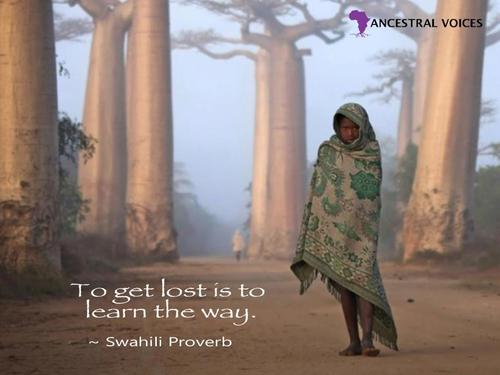 |
The word Liver is derived from the word LIFE. Our length and quality of life can depend on how well our Liver functions. When you see the benefits of consuming liver and the life giving nutrition it offers, it makes sense. Something our ancestors understood well.
The History
Toxins? I used to be concerned about eating liver as I thought it was the storage organ for toxins. While its function is to remove toxic substances from the blood and this is a legitimate concern, the liver does not store toxin. Toxins the body cannot eliminate are more likely to accumulate in the body’s fatty tissues and nervous systems.
So what’s so good about it?
Remember that it is essential to eat meat and organ meats from animals that have been raised on fresh pasture when possible, without hormones, antibiotics or commercial feed. Pasture-raised animal products are much higher in nutrients we need. And pasture-raised eggs have been shown to contain up to 19 times more omega-3 fatty acids than ‘caged’ eggs!
In the table below, Vitamins that stand out are the B Vitamins (Nicain, B6, B12 etc), Folic Acid, Vitamin C, Vitamin A, Iron, Magnesium and Phosphorous. Vitamins & Minerals often sadly lacking in our modern day diets.
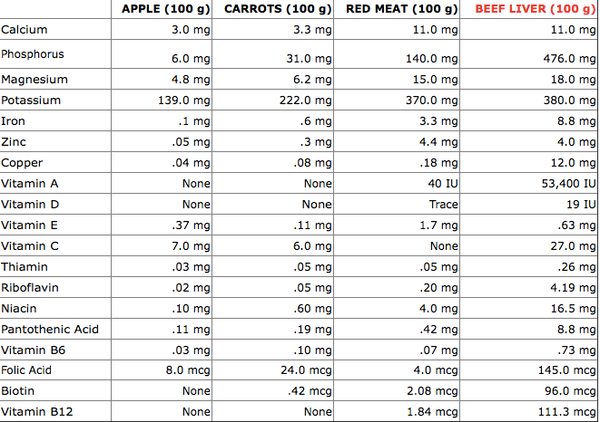 |
Ref. Chris Kresser and Sally Fallon, Nourishing Traditions.
For an easy recipe to try, this Beef Liver Pate recipe is SIMPLE and really good!
If organ meat really isn’t your thing but I’ve peaked your interest, then it is possible to buy it in capsules in a freeze dried form. Just make the source is high quality as indicated above, there are no added ingredients and it’s a reputable brand of supplement.
Now I’d love to hear from you. Are you willing to give this food a go? Or if you do already, how do you add them in to your diet?